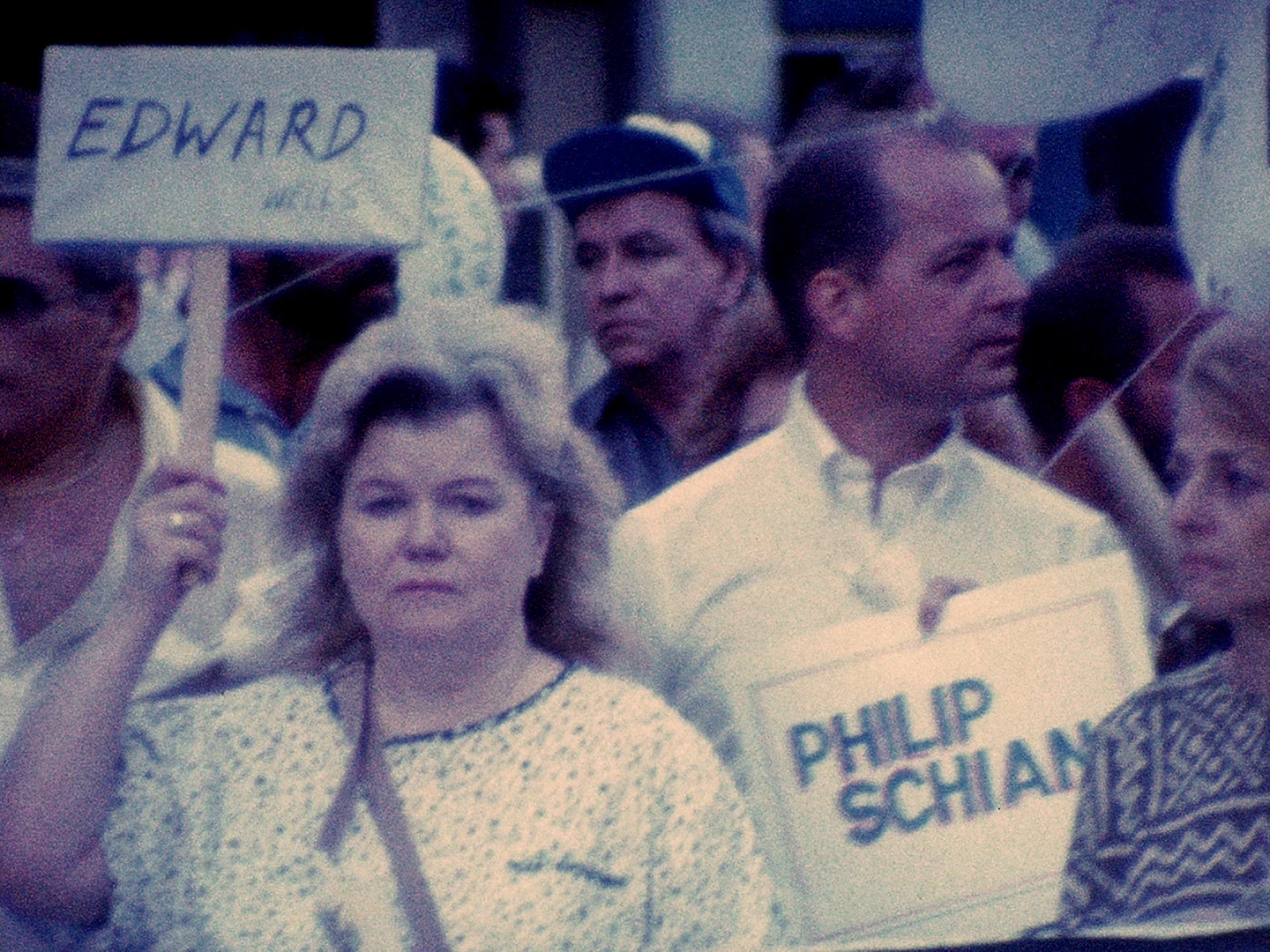Jim Hubbard Lesbian/Gay Community Film Footage
AIDS Candlelight Vigil, Christopher Street, New York City, May 1987. Courtesy Jim Hubbard. Image subject to copyright laws.
Conservation & Capture
Grant years: 2018, 2019
Grant recipient & primary maker: Jim Hubbard
Original format: 8mm, Super 8, 16mm film, silent
Length/feet or running time:
2019: Approx. 675ft of 8mm/Super 8 and 2550ft of 16mm
2018: Approx. 200ft of 8mm, 1,075ft of Super 8, 2,350ft of 16mm
Circa: 1979 - 2009
Lab: Pro8mm
Digital capture format: 8mm/Super 8 footage captured at 2k resolution. 16mm footage captured at 4k resolution
Status: 2018 and 2019 conservation and digital capture completed.
Online Access: In-progress at https://archive.org/details/@allarvickfund
Creative Commons license: Attribution Non-Commercial-NoDerivatives 4.0 International https://creativecommons.org/licenses/by-nc-nd/4.0/
Grantee & Filmmaker
Jim Hubbard. Courtesy Jim Hubbard. Image subject to copyright laws.
Jim Hubbard has been making films since 1974. He made United in Anger: A History of ACT UP, a feature-length documentary on ACT UP, the AIDS activist group, which has played at over 150 museums, universities and film festivals worldwide. Sarah Schulman and he completed 187 interviews for the ACT UP Oral History Project. One hundred and two of them were on view in a 14-monitor installation at the Carpenter Center for the Arts, Harvard University as part of the exhibitionACT UP New York: Activism, Art, and the AIDS Crisis, 1987–1993and at the White Columns Gallery in New York. Among his 19 other films are Elegy in the Streets(1989), Two Marches(1991), The Dance(1992) and Memento Mori (1995). His films are in the collection of the Museum of Modern Art and have been shown at the Warhol Museum, ICA Boston, the Harvard Film Archive, der Zürcher Museen, mumok (Vienna), the Berlin Film Festival, the London Film Festival, the San Francisco Jewish Film Festival, and numerous Lesbian and Gay Film Festivals. His film Memento Mori won the Ursula for Best Short Film at the Hamburg Lesbian & Gay Film Festival in 1995. He co-founded MIX - the New York Queer Experimental Film Festival. Under the auspices of the Estate Project for Artists with AIDS, he created the AIDS Activist Video Collection at the New York Public Library. He curated the series Fever in the Archive: AIDS Activist Videotapes from the Royal S. Marks Collectionfor the Guggenheim Museum in New York. He also co-curated the series, Another Wave: Recent Global Queer Cinema at the Museum of Modern Art in New York. In 2013-14, he curated a screening series at the New York Public Library to accompany the landmark exhibition Why We Fight: Remembering AIDS Activism. To learn more about Jim's work visit jimhubbardfilms.com.
Roger Jacoby, Walnut Street, Pittsburgh, 1978. Courtesy Jim Hubbard. Image subject to copyright laws.
About this Collection
I started making films in 1974. In 1978, I began filming the Lesbian & Gay community. I have continued to film demonstrations and other public events and parties, gatherings and other more private moments of the Queer community ever since. I have always considered this footage to be home movies for the queer community.
The footage originates on Regular-8, Super-8 and 16mm. Almost all of the footage is hand-processed in order to use color to enhance the emotional impact of the image. Hand-processing also allowed me to film at night in very low light and, by push-processing, to make the image visible. When I film demonstrations, I am not seeking to record the mass movement, but to find individuals in the crowd, to evoke the diversity of the multitude and to try to unearth the meaning of the event. The films include the protests against the making in Greenwich Village of the movie Cruising in the Summer of 1979, the protests in New York after the light sentence given to Dan White for the assassination of Harvey Milk and Mayor George Moscone of San Francisco. The footage also comprises Gay Pride Marches from 1982, 1983, 1987, and 1988 and the Gay Pride Runs of 1982 and 1985. There are also some ACT UP protests in Albany, and a Kiss-In and footage from an AIDS Candlelight Vigil on Christopher Street in 1987. All the footage was shot by Jim Hubbard except for 200 feet of Regular-8 that was shot by Roger Jacoby (with shots of Roger by someone unknown). This footage is of his then-lover Ondine, the Andy Warhol Superstar, and Sally Dixon, who headed the Film Section of the Carnegie Museum in Pittsburgh and was a great supporter of Roger’s films.
The films that were digitally captured under the 2019 grant are a continuation of the work that was digitized under the grant in 2018. Here are more home movies for the queer community.
These films include footage shot at the first two Gay Pride Runs that took place in New York in 1982 and 1983, shot on Super-8. There is additional footage from the anti-Cruising demonstrations in the summer of 1979. The films also include Pride Marches from 1985, 1986, 1987 and 1988. All those marches were shot in 16mm and hand-processed. The big surprise from this group is a 50 foot reel of Super-8 shot by Barbara Hammer. Barbara gave this reel to me the last time we saw each other before she died. She told me that it is footage of me shot at the Berlin International Film Festival, though I’m not sure what year. It could have been 1999 or 2009.” ~ Jim Hubbard.
Demonstration against the filming of the movie Cruising, Times Square, Summer 1979. Courtesy Jim Hubbard. Image subject to copyright laws.




